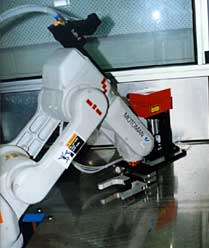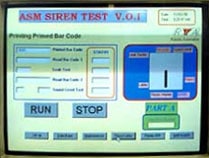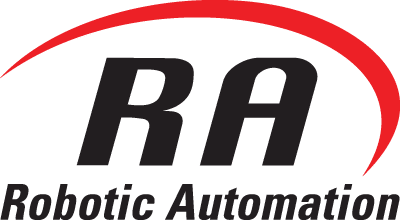Robotic Tending, Testing & Inspection
A.S.M. Industries manufactures products for the Automotive Industry, including car alarm components exported to European markets by it’s customer Robert Bosch (Australia) Pty Ltd, for use by companies such as Opel, Volvo and Audi. To assist in this program, A.S.M. Industries are using a robot at their Clayton, Victoria manufacturing site to ensure the highest possible quality standards are maintained in their manufacturing process.
As a leader in plastic component manufacturing for many industries, A.S.M. performs rigorous testing procedures under their ISO9002 quality program. Utilising robot technology as an integral part of this process ensures testing procedures are duplicated exactly each and every time they are performed. A.S.M. Industries recognise this as one of the primary benefits with robotics; robots perform exactly the same role over and over again without the variables introduced by operators.

With the prohibitive price of dedicated testing machines, A.S.M. Industries approached Robotic Automation Pty Ltd with an idea to work with them to incorporate robot technology into the quality control and testing procedure for a car alarm siren they manufacture. With production which could exceed 400,000 units a year, A.S.M. Industries required a high speed, flexible solution.
The final solution involved a Motoman 3 kg payload robot being interfaced with a PC, a barcode label printer, an ultrasonic welder, a leak test instrument, a sound level meter and barcode readers.
An operator loads 2 components into a fixture where they are clamped and moved into the robot cell. An ultrasonic welder is used to join the plastic components together. When this is completed, the robot picks up the unit and moves it to the barcode printer where the PC generated label is applied. The siren is then moved by the robot to a barcode reader for verification.

If no label is detected, the siren is placed into the “no label” reject shute. If the label is detected, the siren is placed into the fixture, clamped and leak tested. Because the leak tester has the longest cycle, Robotic Automation have programmed the Motoman robot to return to the start and begin the process again with new components. This ensures production occurs as rapidly as possible and all machinery is constantly in use.
If the car alarm siren passes the leak test, it then undergoes a sound test. Providing the siren passes both tests, it is deemed to have successfully passed the quality control procedure and is placed in a shute and presented to the operator. If the unit fails any of these critical tests, the unit is stamped with an “R” and placed in a reject shute.
The data acquisition software used in this process was written by Robotic Automation. It combines the Visual Operator Interface software (VOI) and the automated process. One operator can monitor the entire production process. A.S.M. Industries have been able to drastically reduce their cycle time from approximately 3 minutes per siren to 30 seconds per siren through the use of robotics and associated technology. The eventual aim is to reduce cycle time to around 20 seconds per unit.
